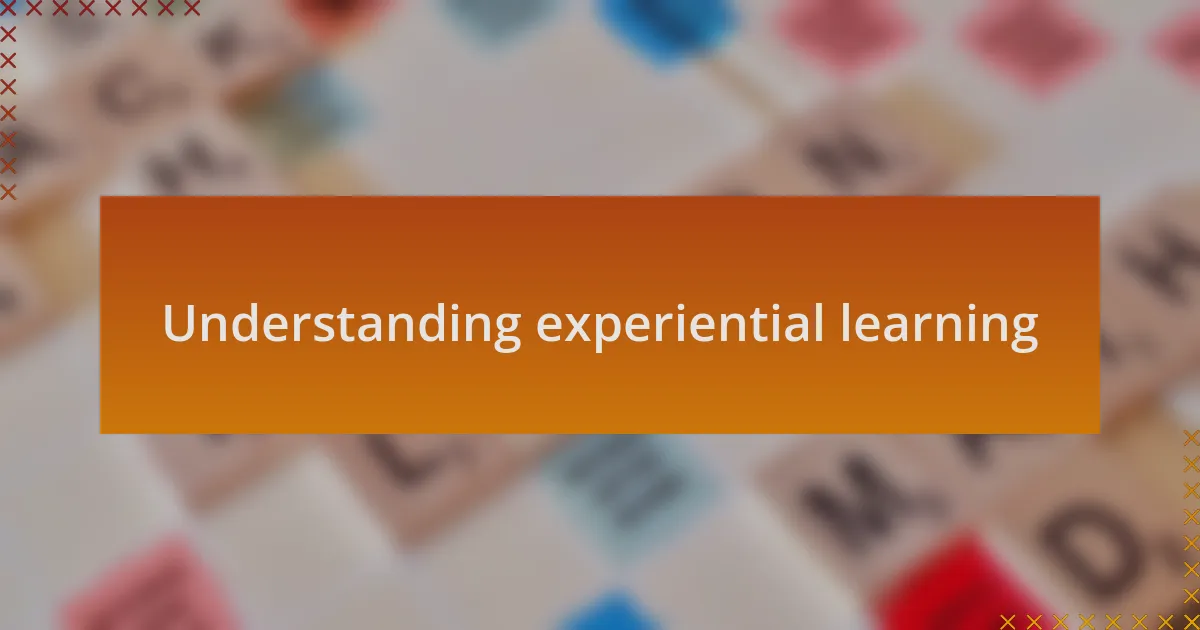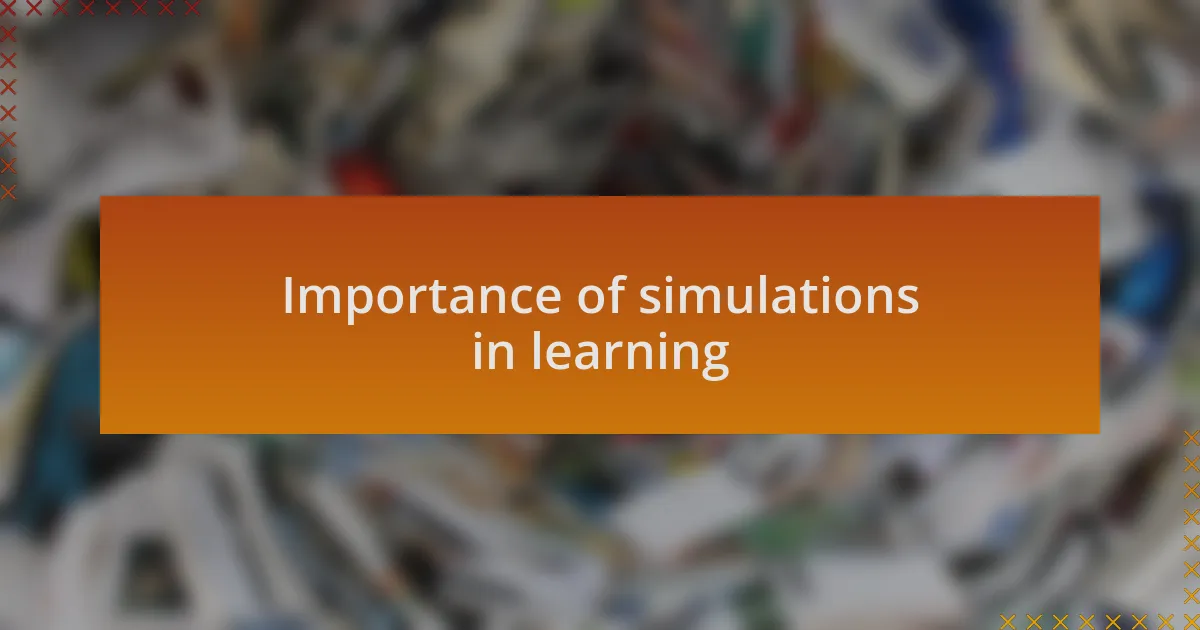Key takeaways:
- Experiential learning enhances understanding by connecting theory to practice, fostering critical thinking and collaboration through hands-on engagement.
- Simulations create safe environments for experimentation, where participants can develop skills and learn from their decisions, leading to deeper learning.
- Key principles of effective simulations include realism, participant feedback, and adaptability, which enhance engagement and learning from unexpected outcomes.
- Reflective practices after simulations transform experiences into practical wisdom, fostering a deeper understanding of the learning journey.

Understanding experiential learning
Experiential learning is all about engaging directly with the material to truly understand it. I still remember the first time I participated in a hands-on workshop rather than a standard lecture; it was a game-changer for me. Have you ever noticed how much more you remember something when you’ve physically done it?
The beauty of experiential learning lies in its ability to bridge theory and practice. I recall designing a simulation that mirrored real-world challenges, allowing participants to tackle problems in real-time. I watched as their eyes lit up with understanding; it became clear that this active involvement was far more impactful than any textbook explanation could ever be.
Reflecting on these experiences, I realize how crucial it is for learners to take ownership of their education. When we immerse ourselves in the process, we not only absorb knowledge but also develop essential skills like critical thinking and collaboration. Isn’t it fascinating how every choice made during these simulations can lead to unique outcomes and insights?

Importance of simulations in learning
Simulations hold a vital place in the learning process because they provide a safe environment for experimentation. I vividly recall a time when I implemented a simulation during a training session. The participants were able to navigate difficult scenarios that would have been high-stakes in the real world. I watched as their confidence grew with each decision they made; it was thrilling to see them truly engage with the material. Have you ever felt that rush of empowerment after successfully navigating a challenge?
Another key aspect is how simulations can foster teamwork and communication skills. I once facilitated a project management simulation where participants had to collaborate to meet deadlines and solve unforeseen issues. The dynamic was incredible; I could see how individuals who started with different perspectives began to meld their ideas and strategies. Doesn’t it feel rewarding to witness growth in others?
Ultimately, simulations encourage deeper learning through trial and error. I remember a participant who struggled initially but found a breakthrough moment when a crucial decision led to unexpected results in our simulation. Witnessing that transformation reminded me of the importance of resilience in learning. Doesn’t that perspective shift help us appreciate mistakes as stepping stones to mastery?

Key principles of effective simulations
One key principle of effective simulations is the necessity of realism. I once designed a simulation that closely mirrored the challenges faced in a specific industry. Participants reported feeling as if they were in the actual workplace, navigating real-time dilemmas. Isn’t it fascinating how realistic scenarios heighten investment and drive engagement?
Another fundamental aspect is participant feedback during the simulation process. During one particular session, I encouraged real-time reflections from learners, allowing them to voice their thoughts and feelings as they faced various challenges. The insights they shared not only enriched their understanding but also created a collective journey. Don’t you think that fostering an environment where learners can express themselves adds another layer of depth to the experience?
Lastly, adaptability is crucial in simulations. I’ve had moments where I had to pivot mid-simulation based on the unexpected choices participants made, which led to surprising outcomes and discussions. The flexibility to adapt enhances learning, allowing participants to explore different paths. Isn’t it exciting to know that sometimes, the most unexpected turns in a simulation can lead to the most profound learning experiences?

Steps to design impactful simulations
When designing impactful simulations, the first step is clearly defining the learning objectives. I recall a project where we set specific goals, like enhancing team collaboration. This clarity helped shape the simulation structure, ensuring every element aimed at achieving our educational targets. Have you ever considered how a focused purpose can guide the entire design process?
Next, I believe in incorporating diverse scenarios that encourage critical thinking. During one simulation, I varied the challenges participants faced—from technical dilemmas to ethical choices. Witnessing their strategic discussions unfold was energizing. This variety not only engaged learners but also mirrored the complexities of real-world decision-making. Isn’t it amazing how bringing multiple perspectives into a simulation can deepen understanding?
Lastly, I always emphasize the importance of reflection after the simulation concludes. I’ve seen participants engage in rich discussions about their experiences, highlighting key takeaways that might have gone unnoticed otherwise. These reflective moments allow learners to internalize their experiences, connecting lessons to their personal and professional lives. Don’t you think that taking time to reflect can transform theoretical knowledge into practical wisdom?

My personal design experiences
In my journey of designing simulations, one experience stands out vividly. I was tasked with creating a simulation for a leadership training program, and I decided to base it on a real-world crisis scenario. Observing how participants navigated the complexities of the situation, I felt a mix of pride and curiosity. Isn’t it fascinating to see how theory transforms into action when people are truly engaged?
Another memorable moment occurred during a team-building simulation. I noticed that when I introduced unexpected challenges, such as a sudden resource limitation, the atmosphere shifted. Participants began to strategize together, their conversations filled with urgency and creativity. It struck me then how important it is to create a safe space for teams to experiment and make mistakes. Have you ever thought about the role of vulnerability in learning?
Reflecting on these experiences, I realize that emotions play a crucial role in the learning process. After one simulation, a participant shared how the experience had changed her perspective on collaboration. Her insights reminded me of the deep connections formed through experiential learning. Isn’t it remarkable how a simulation can resonate with someone on such a personal level, fostering growth that extends beyond the learning environment?

Challenges faced in simulation design
When designing simulations, one of the most significant challenges I faced was ensuring realism without overwhelming participants. I remember once crafting a scenario that mirrored a high-pressure negotiation. While realistic, the complexity led to confusion among participants rather than engagement. It made me ponder: how do we strike the balance between authenticity and clarity in our designs?
Another hurdle was addressing diverse learning styles within a group. I vividly recall a time when I assumed a one-size-fits-all approach would suffice. In doing so, I unintentionally alienated some participants, leaving them feeling disconnected. This experience taught me the importance of incorporating various methods—visual aids, hands-on activities, and storytelling—to cater to different preferences. Have you ever considered how inclusive design can significantly enhance participant experiences?
Finally, I found that managing time during simulations can be particularly tricky. In one instance, I underestimated the duration required for a complex scenario, and the result was a rushed conclusion that left participants unsatisfied. It really made me reflect on the importance of thorough planning and flexibility in simulation design. How do you account for unexpected shifts in time while keeping the learning objectives intact?

Lessons learned from my journey
There’s a profound lesson I learned about the significance of feedback during my simulation design journey. After one particular session, I was eager to hear what participants thought. To my surprise, many expressed that they felt unprepared for the scenario’s demands. This feedback was an eye-opener for me; it highlighted not just the value of participant input but the necessity of pre-simulation briefings. Have you ever overlooked the importance of preparation in your own initiatives?
Another crucial insight revolved around the power of storytelling in simulations. I remember implementing a narrative arc in one simulation, which transformed the learning environment. Participants were not only engaged but emotionally invested, which deepened their learning. This experience led me to realize that incorporating relatable stories can enhance empathy and connection in such learning experiences. How often do we tap into the emotional aspects of learning?
Lastly, I discovered the importance of reflection post-simulation. Initially, I would jump straight into the next task, but I found that taking time to debrief allowed participants to articulate their thoughts and experiences. This shared dialogue not only fostered deeper understanding but also built a community among participants. Have you ever allowed for that crucial moment of reflection after an intense learning experience? It truly can reshape the outcomes.